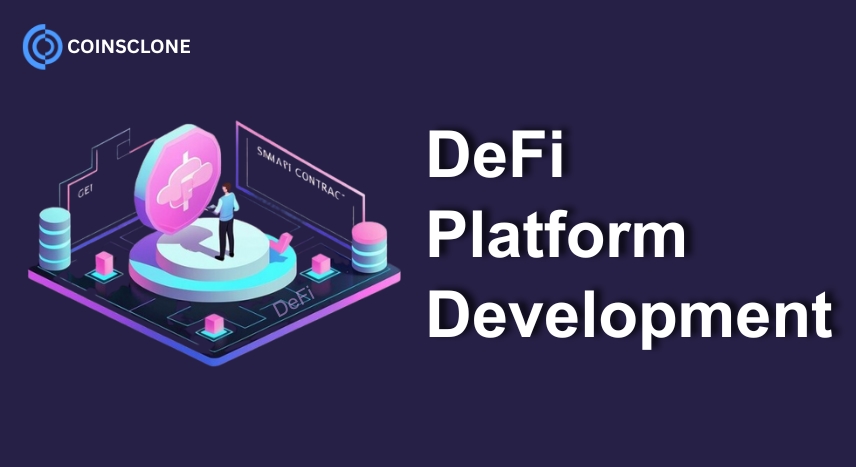
Decentralized Finance (DeFi) is rapidly changing the way financial systems work. By removing intermediaries like banks and brokers, DeFi opens up access to transparent, borderless, and secure financial services for anyone with an internet connection.
If you’re planning to build your own DeFi platform, this guide will help you understand the core concepts, key benefits, leading examples in the market, and a detailed step-by-step process to create your platform successfully.
What is DeFi Platform Development?
DeFi platform development refers to the process of building decentralized applications (dApps) that offer financial services on blockchain networks. These platforms are powered by smart contracts, self-executing programs that operate automatically when predefined conditions are met.
Unlike traditional systems, there is no centralized authority controlling transactions. Instead, the entire process is governed by code, ensuring transparency and eliminating the need for intermediaries.
Through DeFi platforms, users can:
Swap and trade cryptocurrencies directly (DEX)
Lend or borrow assets using crypto as collateral
Earn passive income through staking or liquidity provision
Access stablecoins and synthetic assets
Participate in governance and decision-making through native tokens
Benefits of DeFi Platform Development
Building a DeFi platform brings advantages to both businesses and end users:
Global Reach: Users from anywhere in the world can participate, 24/7.
No Middlemen: Transactions happen peer-to-peer, reducing costs and improving speed.
Transparency: All activities are recorded on the blockchain, ensuring full visibility.
Enhanced Security: Users control their funds, reducing risks associated with centralized custody.
Revenue Opportunities: Platforms can earn through transaction fees, staking models, token sales, and more.
Innovation & Flexibility: You can design unique financial products that don’t exist in traditional systems.
Top DeFi Platforms
Before developing your own platform, it’s wise to analyze successful DeFi projects. These platforms set benchmarks for security, scalability, and user experience:
Uniswap – A leading decentralized exchange for token swaps.
Aave – A popular lending and borrowing protocol.
MakerDAO – Known for DAI stablecoin and decentralized lending.
Compound – A pioneer in algorithmic money markets.
Curve Finance – Specialized in low-fee stablecoin trading.
SushiSwap – A community-driven DEX with yield farming features.
How to Create a DeFi Platform
Building a DeFi platform requires strategic planning and strong technical execution. Here’s a step-by-step breakdown with deeper explanations for each stage:
1. Define Your Niche and Use Case
Start by deciding what type of DeFi product you want to build. This could be a DEX, a lending platform, a yield aggregator, or a stablecoin protocol.
Analyze existing market gaps.
Research your target users’ needs.
Focus on one core feature first instead of trying to build everything at once.
2. Select the Right Blockchain
Your choice of blockchain affects transaction speed, fees, and security.
Ethereum: Offers the largest DeFi ecosystem but has higher gas fees.
Binance Smart Chain (BSC): Faster and cheaper, suitable for wider adoption.
Polygon: A layer-2 scaling solution with lower fees.
Solana & Avalanche: High throughput and ideal for complex applications.
Evaluate the trade-offs between decentralization, cost, and the developer ecosystem before choosing.
3. Design Robust Tokenomics
If your platform has its own native token, tokenomics is crucial. Define:
Total token supply and distribution plan.
Utility of the token (e.g., governance, staking rewards, fee discounts).
Incentives for liquidity providers and early adopters.
Vesting periods to avoid sudden market dumps.
Well-planned tokenomics attract users and ensure sustainable growth.
4. Develop Secure Smart Contracts
Smart contracts are the core engine of your DeFi platform. They automate all transactions and logic.
Use Solidity for Ethereum or Rust for Solana.
Implement functions like deposits, withdrawals, swaps, lending logic, and reward calculations.
Follow security best practices (e.g., input validation, avoiding re-entrancy vulnerabilities).
Get your contracts audited by a reputable security firm to minimize the risk of hacks.
5. Create a Seamless User Interface (Frontend)
Even the most powerful DeFi protocol can fail if users find it difficult to use. Your frontend should:
Integrate smoothly with wallets like MetaMask, WalletConnect, or Trust Wallet.
Display real-time balances, transaction histories, and yield calculations.
Offer clear call-to-action buttons (e.g., “Swap,” “Stake,” “Borrow”) with minimal steps.
Be responsive and mobile-friendly.
A good UI builds trust and encourages user engagement.
6. Integrate the Backend and Middleware
Although DeFi is decentralized, many platforms use backend servers for indexing data, caching, or analytics. Tools like The Graph can help retrieve on-chain data efficiently. You may also integrate oracles (like Chainlink) to bring external price feeds securely.
7. Test on Testnets Thoroughly
Before launching on the mainnet, deploy your contracts on testnets (e.g., Goerli for Ethereum, Mumbai for Polygon).
Run security tests, stress tests, and bug hunts.
Simulate real user interactions and extreme conditions.
Fix vulnerabilities and optimize gas usage.
8. Launch and Promote Strategically
Once testing is complete, deploy on the mainnet and start your marketing campaign:
Announce the launch on social platforms and communities.
Offer incentives like liquidity mining or early user rewards.
Educate users through guides, demos, and webinars.
Building trust and community is key for DeFi success.
9. Monitor, Maintain, and Upgrade
Post-launch, keep improving your platform:
Monitor smart contracts and transactions for anomalies.
Fix bugs quickly and roll out upgrades.
Conduct regular security audits.
Listen to community feedback and adapt your roadmap accordingly.
Conclusion
Building a DeFi platform isn’t just about writing code; it’s about combining strategic vision, strong tokenomics, user-centric design, and iron-clad security.
The DeFi industry is still evolving, which means there’s plenty of room for new ideas and innovations. Start by solving one clear problem, build securely, and grow steadily. With the right approach, your platform could become the next big name in decentralized finance.
